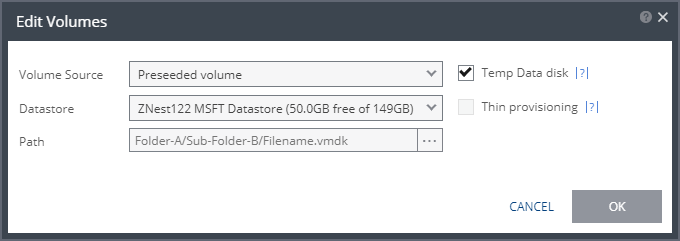Edit Volumes Dialog
To edit recovery datastore information for a protected virtual machine.
Volume Source: The source on the recovery site for the replicated data: Datastore, RDM or Preseeded volume.
Volume Source > Datastore
Datastore: A new volume is used for replicated data. Specify the datastore to use to create disks for the replicated data. If the source disk is thin provisioned, the default for the recovery volume is that it is also thin provisioned.
The datastore specified for replication must have at least the same amount of space as the protected volume and an additional amount for the journal. The amount of additional space needed for the journal can be fixed by specifying a maximum size for the journal, or can be calculated as the average change rate for the virtual machines in the VPG, multiplied by the length of time specified for the journal history.
You can use the vSphere Client console
Performance tab for each virtual machine to help estimate the change rate. For more details, refer to
“WAN Sizing Requirements with Zerto Virtual Replication”, on page 30.
Zerto Virtual Replication supports the SCSI protocol. Only disks that support this protocol can be specified.
Volume Source > RDM
Raw Disk: The VMware RDM (Raw Device Mapping) to use for the replication.
■ By default, RDM is recovered as thin-provisioned VMDK in the datastore specified in the VM Recovery Datastore field in the Edit VM dialog, and not to RDM.
■ You cannot define an RDM disk if the virtual machine uses a BusLogic SCSI controller, nor when protecting or recovering virtual machines in an environment running vCenter Server 5.x with ESX/ESXi version 4.1 hosts.
■ Only a raw disk with the same size as the protected disk can be selected from the list of available raw disks. Other raw disks with different sizes are not available for selection.
■ The RDM is always stored in the recovery datastore used for the virtual machine.
■ The following limitations apply to protecting RDM disks:
■ RDM disks with an even number of blocks can replicate to RDM disks of the same size with an even number of blocks and to VMDKs.
■ RDM disks with an odd number of blocks can only replicate to RDM disks of the same size with an odd number of blocks and not to VMDKs.
Volume Source > Preseeded volume
Whether to copy the protected data to a virtual disk in the recovery site. Zerto recommends using this option particularly for large disks so that the initial synchronization will be faster since a Delta Sync can be used to synchronize any changes written to the recovery site after the creation of the preseeded disk. When not using a preseeded disk, the initial synchronization phase must copy the whole disk over the WAN. When using a preseeded virtual disk, you select the datastore and exact location, folder, and name of the preseeded disk, which cannot be an IDE disk. Zerto Virtual Replication takes ownership of the preseeded disk, moving it from its source folder to the folder used by the VRA. Only disks with the same size as the protected disk can be selected when browsing for a preseeded disk. The datastore where the preseeded disk is placed is also used as the recovery datastore for the replicated data.
If the preseeded disk is greater than 1TB on NFS storage, the VPG creation might fail. This is a known VMware problem when the NFS client does not wait for sufficient time for the NFS storage array to initialize the virtual disk after the RPC parameter of the NFS client times out. The timeout default value is 10 seconds. See the VMware documentation,
http://kb.vmware.com/selfservice/microsites/search.do?language=en_US&cmd=displayKC&externalId=1027919, which describes the configuration option to tune the RPC timeout parameter using the
esxcfg-advcfg -s <Timeout> /NFS/SetAttrRPCTimeout command.
Note the following conditions:
■ If the protected disks are non-default geometry, configure the VPG using preseeded volumes.
■ If the protected disk is an RDM disk, it can be used to preseed to a recovery VMDK disk. Zerto Virtual Replication makes sure that the VMDK disk size is a correct match for the RDM disk.
■ If the VPG is being defined for a Zerto Organization, ZORG, the location of the preseeded disk must be defined in the Zerto Cloud Manager. For details, see Zerto Cloud Manager Administration Guide.
Datastore: The datastore where the preseeded disk is located.
Path: The full path to the preseeded disk.
Temp Data disk: If the virtual machine to be replicated includes a temp data disk as part of its configuration, specify a mirror disk for replication that is marked as a temp data disk. In this case, data is not replicated to the temp data disk after initial synchronization.
Thin provisioning: If the recovery volumes are thin-provisioned or not.



